Species P. edulis | ||
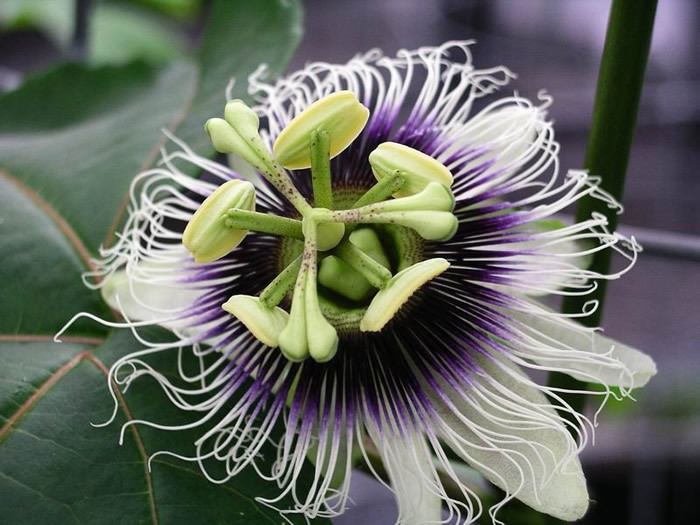 | ||
Similar Fruit, Pitaya, Papaya, Mango, Passion Flower | ||
Amazing timelapse of a passion fruit plant passiflora edulis with sony a6000
Passiflora edulis is a vine species of passion flower that is native to southern Brazil through Paraguay to northern Argentina. Its common names include passion fruit or passionfruit (English), maracuya (Spanish), grenadille (French), maracujá (Portuguese) and lilikoʻi (Hawaiian).
Contents
- Amazing timelapse of a passion fruit plant passiflora edulis with sony a6000
- Passiflora edulis flavicarpa plant fruits and flowers 1080p hd
- Etymology
- Culture
- Varieties
- Uses
- Nutrition
- Viruses
- Phytoplasma
- Bacteria
- Fungal diseases
- References
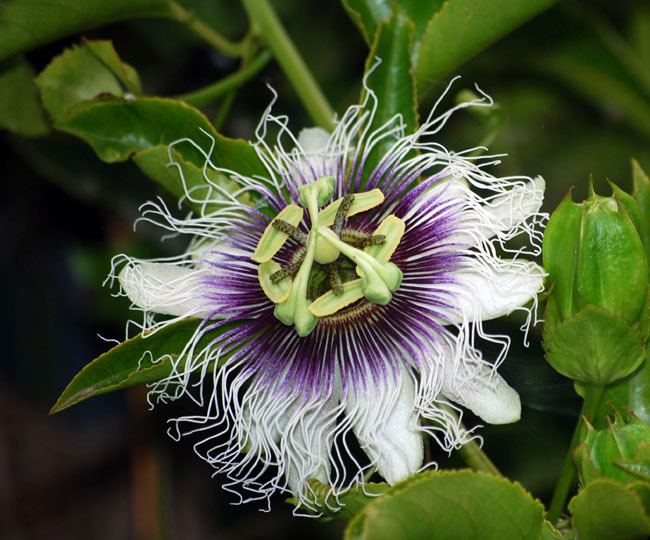
It is cultivated commercially in tropical and subtropical areas for its sweet, seedy fruit. The passion fruit is a pepo, a type of berry, round to oval, either yellow or dark purple at maturity, with a soft to firm, juicy interior filled with numerous seeds. The fruit is both eaten and juiced; passion fruit juice is often added to other fruit juices to enhance aroma.
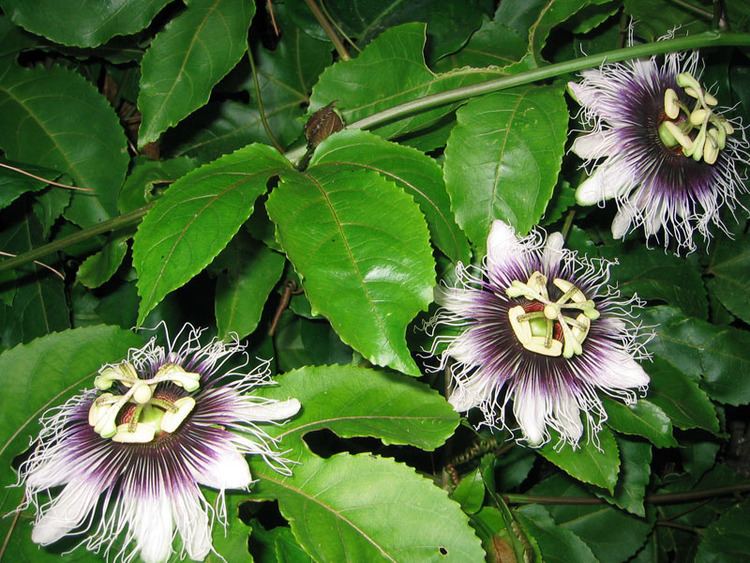
Passiflora edulis flavicarpa plant fruits and flowers 1080p hd
Etymology
The passion fruit is so called because it is one of the many species of passion flower, leading to the English translation of the Latin genus name, Passiflora. Around 1700, the name was given by missionaries in Brazil as an educational aid while trying to convert the indigenous inhabitants to Christianity; its name was flor de las cinco lagas or "flower of the five wounds" to illustrate the crucifixion of Christ, with other plant components also named after an emblem in the Passion of Jesus.
Culture
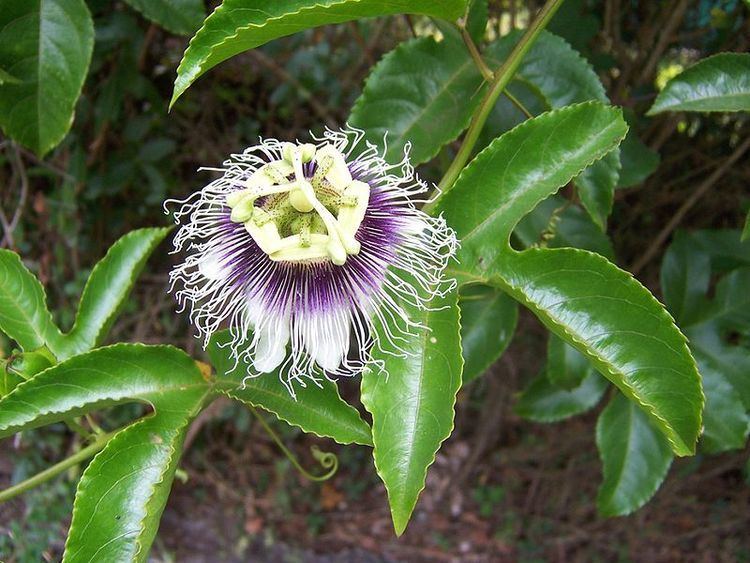
Passion fruit is widely grown in tropical and semitropical regions of the world. Within the United States, it is grown in Florida and California. Certain cultivars are resilient against light frosts, and thus can survive perennially, even in more temperate climates such as that of Great Britain.
Passion fruit flower is the national flower of Paraguay.
Varieties
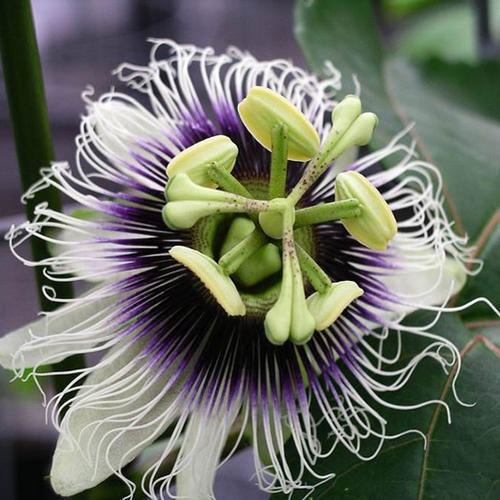
Several distinct varieties of passion fruit with clearly differing exterior appearances exist. The bright yellow flavicarpa variety, also known as the Golden Passion Fruit, can grow up to the size of a grapefruit, has a smooth, glossy, light and airy rind, and has been used as a rootstock for the Purple Passion Fruit in Australia. The dark purple edulis variety is smaller than a lemon, though it is less acidic than the yellow passion fruit, and has a richer aroma and flavour.
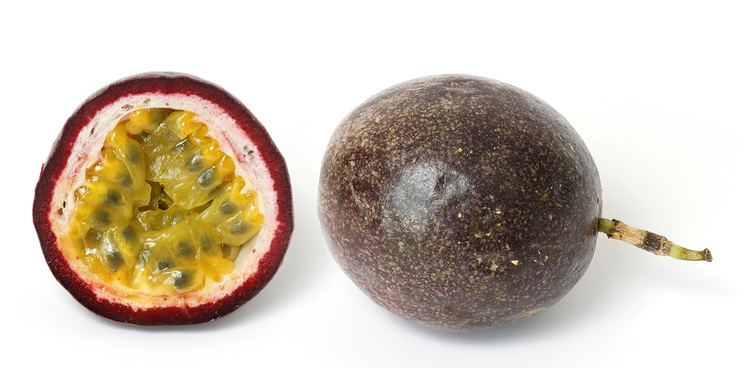
Several varieties of passion fruit are rich in polyphenol content, and yellow varieties of the fruit were found to contain prunasin and other cyanogenic glycosides in the peel and juice.
Uses
Passion fruit has a variety of uses related to its appealing taste as a whole fruit and juice.
Nutrition
Raw passion fruit is 73% water, 22% carbohydrates, 2% protein and 0.7% fat (table). In a 100 gram amount, fresh passion fruit contains 36% of the Daily Value (DV) of vitamin C, 42% dietary fiber, B vitamins riboflavin (11% DV) and niacin (10% DV), 12% iron and 10% phosphorus (right table). No other micronutrients are in significant content.
Viruses
Passion fruit woodiness virus is one of the most well known viruses to the passion fruit. It belongs to the Potyvirus group and can attack a plant at any age from nursery to mature plants. Some features include yellow leaves that display distortion in the leaf length and shape. As well as affecting the leaf, this virus influences fruit shape and size. Affected fruits become stone-like and much smaller than normal, with many fruits becoming scabbed and cracked. The virus is spread by sap-sucking insects such as aphids and mites. Woodiness can also spread through vegetation propagation such as infected scions or contaminated tools. There is no chemical control for this virus once the plant is infected, but the use of clean planting material can reduce its dissemination.
One of the most serious viruses pertaining to vegetation is the Cucumber mosaic virus. In the passion fruit, this virus appears with yellow mottling on leaves starting at random points on the vine and diminishing in intensity towards the tip. Expanding leaves typically become twisted, curl downward, and develop a "shoestring" appearance as a result of a restriction of the leaf surface. It is mobile and can spread easily through interactions with other plants such as brushing between leaves. This virus is naturally transmitted through aphids and can also be transmitted mechanically through seedlings. Varietal resistance is the primary management tool, and eliminating weeds and infected perennial ornamentals that may harbor the virus is critical. Once the plant has been infected, there is no possible management of control for the virus.
Phytoplasma
Overshooting is the term used when Phytoplasma, a specialized bacterium, attacks the phloem of a plant. Phytoplasma infection is characterized by chlorotic small leaves, shortening of internodes, excessive lateral shoots and abnormal flowers. Although there have been reports of this disease within the passion fruit plant, many infected plants are affected without visible signs of disease. Although Phytoplasma can be spread through grafting, it can be inhibited by periodic inspection of plant nurseries and areas that have had past infections. Overshooting responds to treatment with tetracycline, a common broad-spectrum antibiotic.
Bacteria
Bacterial leaf spot, which causes vein clearing, forms bright yellow colonies causing infection and leaf wilt and, eventually, deterioration of fruit pulp, especially of young fruits. Under favorable conditions for the bacteria, infection occurs through natural openings or wounds from other pathogens that affect leaf inter-cellular spaces. Fertilizers or a copper chloride and mancozeb mixture can control the intensity of the disease, but are not a cure.
The bacterial grease-spot of the passion fruit is caused by Pseudomonas syringae. It appears with olive-green to brown greasy-looking spots or brown, sunken circular lesions. On a later stage, a hard crust can cover the lesions showing a chlorotic halo. Affecting mainly the stomata, the grease-spot thrives in high temperatures and high relative humidity. To avoid infection, measures that may be adopted include planting seeds from healthy plants and using existing healthy areas. Fungicide controls can aid in preventing further infection.
Fungal diseases
Collar rot disease is caused from the fungus Fusarium solani. It is characterized by necrotic lesions at the collar region, browning of the stem at soil level, and dark discoloration of the stem. The rotting stem interferes with food and water transport within the plant, leading to withering of the plant until death. Infection occurs mostly through contaminated soil and infected plants which cause the plants to survive for only a few weeks. There are no chemical controls. Management includes planting seedlings in unaffected areas and using clean tools.
The fungus called fusarium wilt commonly occurs in adult plants and is caused by Fusarium oxysporum. The pathogen has ability to survive for long periods, penetrating roots, invading the xylem and preventing the transport of water and nutrients to other organs of the plant. Once infected, this disease causes leaves to yellow and browning of the vascular system until it wilts and dies. It occurs in any type of soil infecting all plants. Management of crops include planting clean seedlings, uprooting and burning infected plants, and using sterilized tools.
The anthracnose, a canker caused by Colletotrichum gloeosporiodes, is a pathogen of the passion fruit creating dark and sunken lesions of the trunk. By attacking mature passion fruit trees, these lesions cause intense defoliation and fruit rot. Many leaves die due to the foliar lesions and the skin of fruits becomes papery. Under warm and humid conditions, this disease can worsen, causing red and orange spores eventually killing the plant. Infection is carried out through the residues of the passion flower, infected seeds, seedlings, and cuttings. Managing this disease involves a combination of using pathogen-free seedlings, eliminating infected areas, and improving ventilation and light conditions. Copper-based fungicides on injured areas can prevent the spread of disease.
